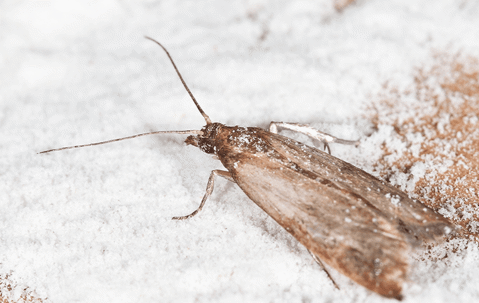There’s a reason your grandma’s closet always smelled like mothballs – moths are no fun! They ruin clothes, they contaminate certain foods, and they drive you nuts flying around the lightbulb all night. Here on Long Island, we’ve got our fair share of pest moths that can ruin homeowners’ days. They’re not the worst pest you can get in your home – not by a long shot – but that doesn’t mean you want to roll out the welcome mat either. Fortunately, there are plenty of things you can do to keep moths out of your house.
Common Area Moths
There are around 160,000 species of moths globally, and we have over 1,000 right here in New York state alone. However, there are just a handful of species that are responsible for most of the pest problems you’ll encounter:
- Pantry Moths: Pantry moths include species like grain moths, flour moths, and Indian meal moths. While these are distinct species with different looks and behavior, they all have one thing in common: they infest your pantry and ruin your food stores. Pantry moths typically go for grain-based food stores. They might damage cereals, rice, barley, flour, and cornmeal. Anything made out of grain is fair game to these moths’ larvae, and they can plow through your stores for weeks or months without you realizing it until they’ve already ruined your food. Infested grain, flour, etc., usually have a foul smell and rotten taste.
- Clothes Moths: Clothes moths eat clothes, but they don’t limit their scavenging to just what you wear. They’ll go for any fibers they find suitable, including rugs, upholstery, and drapes. The larvae of clothes moths will eat any natural fabric, including cotton, wool, and silk. Basically, if it isn’t a synthetic fiber, it could be vulnerable to clothes moth damage. Articles in storage drawers or folded on shelves are especially vulnerable, as are fabrics kept in homes that are empty a lot of the time.
Moth Prevention
Moths don’t just pose problems indoors. The caterpillars from many moth species can also cause serious damage to your shrubs, trees, and garden. While clothes moths and pantry moths are more of a problem in the fall and winter as they seek shelter indoors to escape the cold, spring and summer are prime outdoor caterpillar seasons. Some moth caterpillars can skeletonize plants, eating every last leaf until the whole thing is nothing but a stem. If you get a large number of them, caterpillars can do a number on your home’s landscaping.
With the amount of destruction ravenous caterpillars can wreak, it’s no wonder homeowners want to prevent them. Keeping moths out of your home is easier than keeping them off your property entirely. To keep the moths outside, take measures like:
- Screen all windows and doors or keep them closed at all times.
- Make sure existing screens are free of rips and tears.
- Keep foods that could attract moths in airtight containers.
- Inspect and air out drawers, closets, and wardrobes regularly.
- Place fabrics in vacuum-sealed bags if they’re going to spend much time in storage.
What To Do About Moth Infestation
If you find moths in your home, they can be tough to get rid of. You should avoid using mothballs. They will kill moths, but they’re also toxic to people and pets. They can cause gastrointestinal and neurologic symptoms. Children and pets can also swallow them, thinking they’re candy. That’s why calling the experts is a better choice. Here at Parkway Pest Services, we can handle anything moths have to throw at us in a way that’s much safer and more effective than smelly, toxic mothballs. So call us at (888) 695-6490, or visit our contact page to schedule your home pest control service today!

